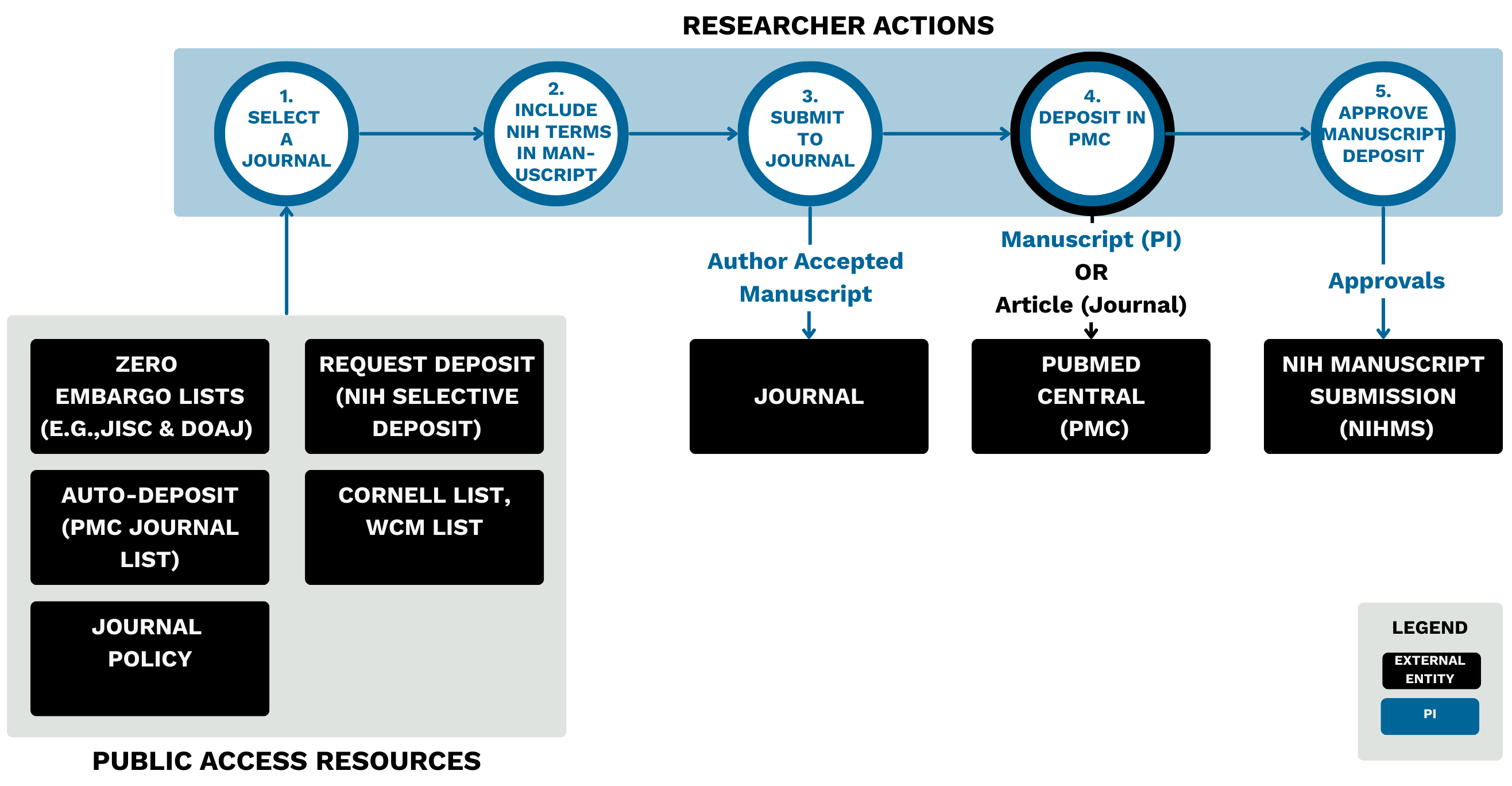The NIH Public Access Policy has new requirements for publishing journal articles based on NIH-funded research. Use the flowcharts and references on this page to plan and finalize your publications.
NIH Public Access Policy Overview
The NIH Public Access Policy requires NIH-funded Author Accepted Manuscripts accepted for publication in a journal to be deposited in PubMed Central:
- upon acceptance for publication
- for public availability without embargo
- upon the official date of publication.
Researchers can take the following five steps to comply with the policy:

1. Select a Journal—Read a journal's policies and use public access resources to see if a journal's policies align with the public access policy.
2. Include NIH Terms in Manuscript—Include relevant NIH public access policy language in your manuscript.
3. Submit to Journal—Submit the Author Approved Manuscript to the eligible journal.
4. Deposit in PMC–Based on the deposit method, deposit your Author Approved Manuscript in PubMed Central or have the journal deposit the Final Published Article automatically or by request with zero embargoes upon the date of publication.
5. Approve Manuscript Deposit—Give initial and final manuscript approvals in the NIH Manuscript Submission (NIHMS) system.
Each step is described in a section below.
Note: You can also use this quick checklist.
Note: For more information, see the SPARC Guide for Authors Complying with U.S. Federal Agency Public Access and Publisher Policies.
To comply with the NIH public access policy, you can submit to journals that allow for an article to be submitted to PubMed Central with zero embargo upon the date of publication.
The following flowchart shows an overview of evaluating a journal:

Read a journal’s policies and check the following resources to find information about fees, possible embargoes, and licensing.
Check if the journal meets one of the following criteria:
A. The journal is zero embargo. Is the journal:
- Open Access/Zero Embargo: In DOAJ or JISC lists.
- You can also search publisher websites for key terms like “self-archiving” or “green OA” (Open Access).
- Author Accepted Manuscript (AAM) Deposit: In a WCM list where authors can deposit AAMs to PMC with no additional fees.
- Auto-deposit to PMC: In the PMC journal list with an Agreement Status of Active and a Release Delay (Embargo) of Zero Months.
- Deposit to PMC by request: In NIH's Selective Deposit list.
B. Cornell or WCM has a publisher agreement to cover Open Access costs.
C. There are no Article Processing Charges (APCs). See: Authors Alliance NIH FAQs.
- OR: D. Article Processing Charges are allowable costs to the NIH.
- NIH will pay for reasonable costs: “the nature of the goods or services acquired or applied and the associated dollar amount reflect the action that a prudent person would have taken under the circumstances prevailing when the decision to incur the cost was made.”
- Costs must be for originally-approved activities and not for any new work outside the period of performance.
- NIH will not cover:
- Costs for a right or a license to deposit Author Accepted Manuscripts to PubMed Central (author deposit is free).
- Disreputable journals.
- Peer review, and costs for services for which there is no resulting publicly available product.
- Double-counting costs (e.g., the institution already paid a journal subscription fee that covers publication).
- Costs after award closeout.
- If the costs are not allowable, you can submit to another journal or pay APCs using discretionary or other non-sponsored funds.
- For specific questions about allowable charges on your grant, contact your Research or Department Administrator.
- NIH will pay for reasonable costs: “the nature of the goods or services acquired or applied and the associated dollar amount reflect the action that a prudent person would have taken under the circumstances prevailing when the decision to incur the cost was made.”
- AND E. The award is open.
- Publication costs may be charged to NIH after the period of performance and before closeout (i.e., during the 120-day liquidation period).
- If the award is closed, pay APCs using discretionary or other non-sponsored funds.
OR: F. Pay APCs with discretionary/other non-sponsored funds.
- If you do not have sufficient funds, select a different journal.
Note: For help in selecting applicable journals and navigating open access fees, reach out to your library liaison or open-scholarship@cornell.edu.
Note: Simply publishing an open access article does not make you compliant with this policy; you must deposit an Author Approved Manuscript to PubMed Central.
Note: If you choose a closed journal, you can use your Federal purpose license (sometimes called a government use license) on the grant to deposit the article to PubMed Central; however, if depositing the article to PubMed Central with zero embargo violates the journal’s agreement, the article may not be published, or you may face other legal actions.
- Include a clear, public-facing acknowledgement of NIH funding in the Author Accepted Manuscript and Final Published Article. NIH suggests the following:
- “This manuscript is the result of funding in whole or in part by the National Institutes of Health (NIH). It is subject to the NIH Public Access Policy. Through acceptance of this federal funding, NIH has been given a right to make this manuscript publicly available in PubMed Central upon the Official Date of Publication, as defined by NIH.”
- Notify the journal/publisher that your article falls under the NIH public access policy.
- Submit your manuscript to your selected journal.
Once the final Author Accepted Manuscript is accepted for publication, the article must be deposited in PubMed Central to be compliant with the Public Access Policy.
- The Author Accepted Manuscript you deposit in PubMed Central should be the author’s final version that has been accepted for journal publication and includes all revisions resulting from the peer review process, including all associated tables, graphics, and supplemental material.
To comply with the NIH Public Access Policy, deposit articles one of three ways:
- PI or Proxy: You or a proxy (grad students, fellows, co-authors, or others) deposit the Author Approved Manuscript to PMC upon the date of publication via the NIH Manuscript Submission (NIHMS) system.
- Journal Auto-deposit: Journals with agreements auto-deposit the Final Published Article to PMC.
- Journal Deposit on Request: Selective Deposit journals deposit the Final Published Article to PMC upon author request.
PubMed Central Deposits
The NIH workflow shows an overview of depositing an article to PubMed Central through the NIH Manuscript Submission (NIHMS) system.
Note: The embargo referenced in step 6 no longer applies.
- Preprints are not acceptable; you must use the final Author Accepted Manuscript that includes peer-review revisions.
- You only need one deposit per article to PubMed Central, even if there are multiple NIH-funded authors.
- If there are multiple NIH funding sources, you can link multiple NIH award numbers to your article in PubMed Central.
- Journals are not required to make their content “immediately, publicly available” as long as the Author Accepted Manuscript is publicly deposited in PubMed Central upon the official date of publication.
For all three deposit options, in the NIH Manuscript Submission (NIHMS) system:
- Approve the initial submission for processing, and
- Give a final approval of the formatted article for inclusion into PubMed Central.
Note: You must submit initial and final approvals in the NIHMS system even if a journal deposits your Author Accepted Manuscript to PubMed Central on your behalf.
Identifiers
The approval process for PubMed Central deposits may take up to three months.
- When Author Accepted Manuscripts are deposited into PubMed Central, an NIH Manuscript Submission Identifier (NIHMSID) is automatically assigned.
- The NIHMSID may be used for three months following the official date of publication until the approval process is complete.
- When the process is complete, the article is assigned a PubMed Central Identifier (PMCID).
- If a journal deposits a Final Published Article on the author’s behalf with no embargo, NIH considers the publication to be provisionally compliant until a PMCID is issued; no author action is required.
- If the journal is not auto-depositing to PubMed Central, confirm the article has a PMCID no later than three months after the official date of publication; if there is no PMCID by the deadline, contact the Public Access Help Desk.
- To demonstrate compliance with the public access policy, include the PMCID when citing manuscripts.
Update ORCID
Update your list of scholarly works tied to your unique, universal research Open Researcher and Contributor Identifiers (ORCID) with the PMC ID for the article.
Note: For more, see: https://guides.library.cornell.edu/orcid.
Q1. If I already have a paper submitted BEFORE July, but it was accepted AFTER July, what do I do?
A: The NIH public access policy requires that Author Accepted Manuscripts (AAM) that were accepted for publication on or after July 1, 2025 be submitted to PubMed Central upon acceptance for publication without embargo, upon the date of publication.
Please communicate with the journal/publisher that your manuscript is the result of NIH funding, and so subject to the NIH public access policy. If there is not a path to allowing the AAM to be published without embargo, you may have to choose a different journal.
Please contact your library liaison or open-scholarship@cornell.edu for more assistance.
Q2. What journal should I submit to?
A: For help in selecting applicable journals and navigating open access fees, see: 1. Select a Journal and reach out to your library liaison or open-scholarship@cornell.edu.
Q3. What does the NIH mean when it says: "NIH will not pay for Article Processing Charges to deposit articles in PubMed Central"?
A: Depositing articles in PubMed Central is free. If a journal deposits an article in PubMed Central on your behalf, they cannot charge you solely for that deposit. However, journals can charge publishing fees in general.
Q4. What types of manuscripts are covered under the public access policy?
A: The policy includes Author Accepted Manuscripts resulting from NIH funding in whole or in part through:
- A grant or cooperative agreement, including training grants
- A contract
- Other Transactions
- NIH intramural research, or
- The official work of an NIH employee.
Author Accepted Manuscript (AAM): The author’s final version that has been accepted for journal publication and includes all revisions resulting from the peer review process, including all associated tables, graphics, and supplemental material.
Date of Publication: The date on which the Final Published Article is first made available in final, edited form, whether in print or electronic (i.e., online) format.
Final Published Article (FPA): The journal's authoritative copy, including journal or publisher copyediting and stylistic edits, and formatting changes, even prior to the compilation of a volume or issue or the assignment of associated metadata.
Open Access (OA): Immediate, unrestricted worldwide access to scholarly content; authors retain their copyright and can specify how their work is reused (e.g. Creative Commons). Publishing OA often incurs additional charges, referred to as Article Processing Charges (APCs).
Public Access: Availability of peer-reviewed scholarly outputs, including publications and data, without cost. Public Access reflects the U.S. government’s commitment to let taxpayers read and access the results of federally funded research for free.
Public Access Policy (PAP): A policy or mandate requiring public access to research results. PAPs exist for many federal funders - including NIH - ensuring that the public has access to the taxpayer-funded research.
PubMed Central (PMC): A free full-text archive of biomedical and life sciences journal literature at the U.S. NIH’s National Library of Medicine (NLM).
Note: Some definitions are sourced from NIH policy.
Contacts
- For help in selecting applicable journals and navigating open access publishing, reach out to your library liaison or open-scholarship@cornell.edu.
- For questions about allowable charges, contact your Research or Department Administrator.


